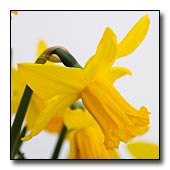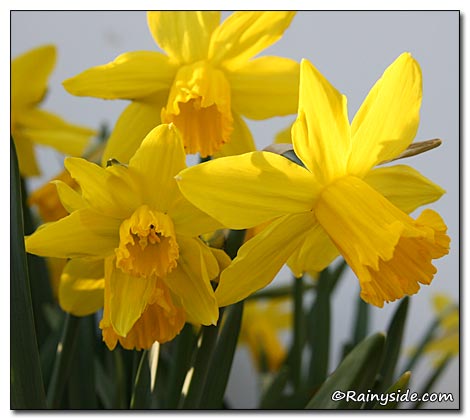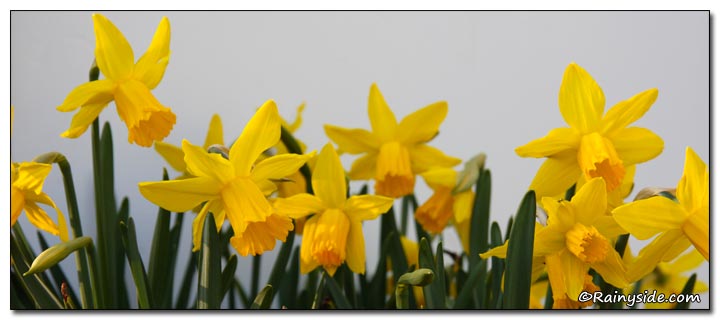Narcissus cyclamineus 'February Gold'
CYCLAMINEUS DAFFODIL
syn. N/A
Family: Amaryllidaceae
Pronounced: nar-SIS-us sik-la-MIN-ee-us

Quick Jumps
Growing Guide
Rainy Side Notes
GROWING GUIDE

Origin:
Garden.
Plant group:
Bulbs.
Hardiness:
Sunset zones: All.
USDA zones: USDA zones: Daffodils will grow in all USDA zones with the exception of southern Florida or warmer areas.
Mature size:
Height: 12-24 inches (15-20 cm).
Flowering period:
Late winter to early spring.
Flowering attributes:
Stem bears one flower. Yellow perianth slightly reflexed, with a yellow cup.
Leaf attributes:
Long, strap-like, green leaves.
Growth habit:
Clump-forming.
Light:
Full sun to dappled shade.
Soil:
Humus rich, moist, well-drained soil.
Feeding:
After flowering, apply a low nitrogen/high potash fertilizer. At planting time, toss bone meal or high potash fertilizer into planting hole.
Propagation methods:
After the leaves dry up, lift bulbs and separate them to increase supply.
Pruning methods:
Deadhead spent flowers to prevent seed formation so the plant's energy goes into the bulb, not seed production. Do not cut foliage off until it dies down. The foliage helps feed the bulb for next year's flowers; it is important that it stay on the plant until it turns brown. Naturalized in grass, the daffodil foliage needs to ripen for at least six weeks after flowering, before mowing.
Pests and diseases:
Slugs may be a problem. In poorly drained soil, bulb rot may occur.
Rainy Side Notes

Here we are in February a little over halfway through winter, and the one thing I can count on is this: Some flowers in the garden defiantly withstand all the trauma this month’s weather can throw at them. Besides, what better way to say, "Spring is on its way," than enjoying a classic yellow, early blooming, cyclamineus daffodil—Narcissus 'February Gold'? It did not get its moniker for nothing; it's a welcome relief of brightness in our rainy, gray, late winter Pacific Northwest gardens. I am keen on this popular little gold gem that peeks out over the water-soaked garden in February. Even though this old variety is smaller than the average later-blooming daffodil, this daffodil packs a wallop with cheeriness, when I need it most! It's enough to make me hop up and down, clap my hands, and sing aloud. If the neighbors think I'm crazy, that's okay. Gardeners sometimes are a little touched in the head when it comes to our gardens. Right? RIGHT?
Plant them in large groups or let them naturalize for the best effect in the garden.
As with most daffodils, N. 'February Gold' is first-rate for forcing and is also an excellent cut flower. Daffodils last four to six days in a vase. Preservatives do not prolong the flowers; this step is not necessary. The blossoms secrete a mucous from their stems that is unfavorable to other cut flowers. Daffodils can be used alone in the vase or hardened for 12-24 hours in freshwater by themselves, with at least one water change. Rinse stems before combining with other cut flowers.
In fall, plant bulbs four to six inches deep and three to six inches apart. The flowers face a southerly direction towards the sun, so you want to plant them with their flower faces towards the viewer.
Daffodils are harmful if eaten, and the bulbs can be a skin irritant.
Photographed in author's garden.

Gardening for the Homebrewer: Grow and Process Plants for Making Beer, Wine, Gruit, Cider, Perry, and More
By co-authors Debbie Teashon (Rainy Side Gardeners) and Wendy Tweton
Copyright Notice | Home | Search | Bulbs

